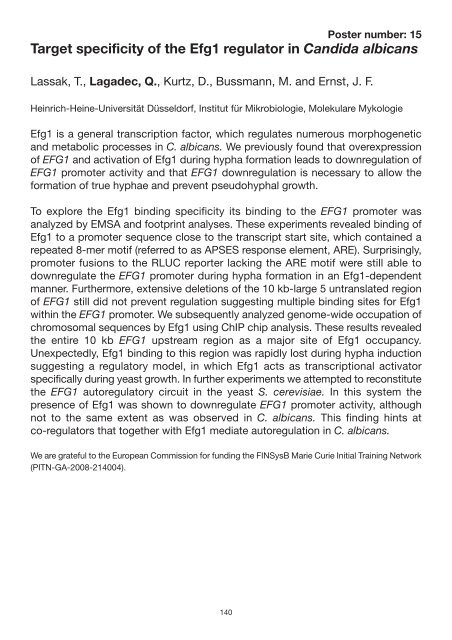Candida Infection Biology – fungal armoury, battlefields ... - FINSysB
Candida Infection Biology – fungal armoury, battlefields ... - FINSysB
Candida Infection Biology – fungal armoury, battlefields ... - FINSysB
You also want an ePaper? Increase the reach of your titles
YUMPU automatically turns print PDFs into web optimized ePapers that Google loves.
Poster number: 15<br />
Target specificity of the Efg1 regulator in <strong>Candida</strong> albicans<br />
Lassak, T., Lagadec, Q., Kurtz, D., Bussmann, M. and Ernst, J. F.<br />
Heinrich-Heine-Universität Düsseldorf, Institut für Mikrobiologie, Molekulare Mykologie<br />
Efg1 is a general transcription factor, which regulates numerous morphogenetic<br />
and metabolic processes in C. albicans. We previously found that overexpression<br />
of EFG1 and activation of Efg1 during hypha formation leads to downregulation of<br />
EFG1 promoter activity and that EFG1 downregulation is necessary to allow the<br />
formation of true hyphae and prevent pseudohyphal growth.<br />
To explore the Efg1 binding specificity its binding to the EFG1 promoter was<br />
analyzed by EMSA and footprint analyses. These experiments revealed binding of<br />
Efg1 to a promoter sequence close to the transcript start site, which contained a<br />
repeated 8-mer motif (referred to as APSES response element, ARE). Surprisingly,<br />
promoter fusions to the RLUC reporter lacking the ARE motif were still able to<br />
downregulate the EFG1 promoter during hypha formation in an Efg1-dependent<br />
manner. Furthermore, extensive deletions of the 10 kb-large 5 untranslated region<br />
of EFG1 still did not prevent regulation suggesting multiple binding sites for Efg1<br />
within the EFG1 promoter. We subsequently analyzed genome-wide occupation of<br />
chromosomal sequences by Efg1 using ChIP chip analysis. These results revealed<br />
the entire 10 kb EFG1 upstream region as a major site of Efg1 occupancy.<br />
Unexpectedly, Efg1 binding to this region was rapidly lost during hypha induction<br />
suggesting a regulatory model, in which Efg1 acts as transcriptional activator<br />
specifically during yeast growth. In further experiments we attempted to reconstitute<br />
the EFG1 autoregulatory circuit in the yeast S. cerevisiae. In this system the<br />
presence of Efg1 was shown to downregulate EFG1 promoter activity, although<br />
not to the same extent as was observed in C. albicans. This finding hints at<br />
co-regulators that together with Efg1 mediate autoregulation in C. albicans.<br />
We are grateful to the European Commission for funding the <strong>FINSysB</strong> Marie Curie Initial Training Network<br />
(PITN-GA-2008-214004).<br />
140


